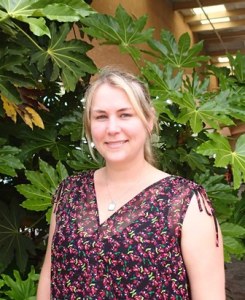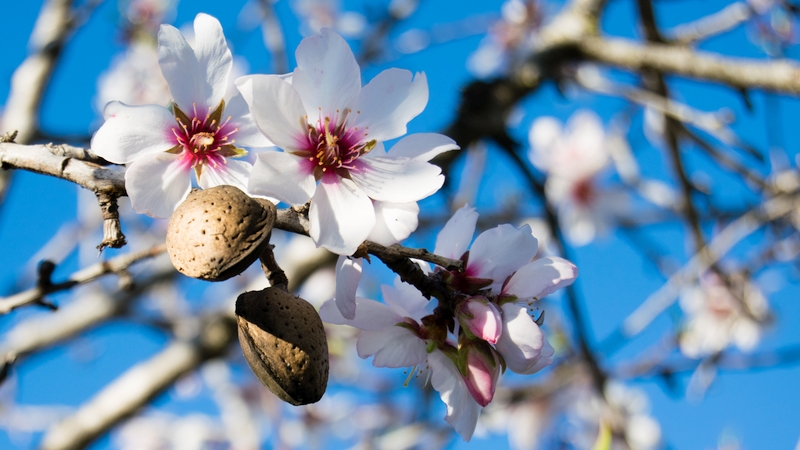Meet The IPM Expert: Emily J. Symmes, UC Cooperative Extension
 Q: What interests you about farming in general and nut growing in particular? Why?
Q: What interests you about farming in general and nut growing in particular? Why?
Symmes: My interest in farming was borne out of my love of being outdoors and observing nature. The ecological interactions between plants and insects in particular led me to discovering the field of entomology. I knew early on that the practical application of gaining expertise in entomology and plant pathology could be a great benefit to the agricultural industry and the environment. Although in my current position as IPM advisor for the Sacramento Valley I am consulting on a range of crops, nut crops are a major interest and focus of my program. Almonds and walnuts are major commodities in the counties I cover (Butte, Colusa, Glenn, Sutter, Tehama and Yuba), allowing me ample opportunity to develop successful research and outreach programs for these crops tailored to the pest management issues specific to the northern part of the Sacramento Valley.
Q: How familiar are you with California? With the Sacramento Valley? What drew you to the area?
Symmes: I was born and raised in the Sacramento Valley (Butte County mostly). After leaving to pursue my college education, I always knew that I wanted to return to this area. There are many wonderful things about this part of the state, the agricultural community being one of the highlights. California, in general, is very unique in the diversity of crops and nature of agricultural production, and the Sacramento Valley is a great representation of this.
Q: Are you very familiar with the industry?
Symmes: I am quite familiar with California agriculture and nut growing in particular. Growing up surrounded by orchards and fields of various crops provided early exposure to agricultural production. I began working in the industry as a young teenager with a local pest management consulting company. I started out fielding phone calls and assembling traps, and quickly moved into the field as a scout. Since that time, I have been continuously involved in a variety of agricultural commodities across the state through research, outreach, education and employment.
Q: Your specialty is Integrated Pest Management, correct? How did you get interested in IPM? What does an IPM advisor do day-to-day?
Symmes: Yes, my specialty is IPM. My early mentor, Dr. Barry Wilk, owner of the company that gave me my start in the industry, was instrumental in introducing me to the concept and a great champion of the principles of IPM. As I moved through my education, obtaining degrees in entomology from UC-Riverside and UC-Davis, I maintained focus on the principles of IPM and how these can be used to improve agriculture. I was honored to work with Dr. Frank Zalom as my major professor at UC-Davis. One of the pioneers of the UC Statewide IPM Project (now Program) in the late 1970s and early 1980s, Dr. Zalom’s experience and guidance further cemented my passion for IPM.
On a day-to-day basis, one of my favorite things about being an IPM advisor is the ability to don many different hats. We are researchers, educators and problem-solvers, among others. Some days are filled with research activities, other days presenting information at meetings, and still others writing and publishing for broader dissemination of information. Most importantly, though, as UC Cooperative Extension advisors, we are here to serve the needs of the agricultural community in whatever form that takes each day.
Q: Have you set any short-term goals as of yet? Any long-term goals?
Symmes: Over the past several months, one of my chief goals has been to begin building relationships with growers, pest control advisors, industry representatives and the great network of university cooperative extension advisors and specialists. Establishing these relationships has allowed me to begin assessing the agricultural climate and gain a better understanding of the critical pest management issues that need to be addressed. In the short- and long-term of my career, continuing to foster these relationships will allow me to maintain an understanding of the practical challenges facing the agricultural industry so that I can deliver timely and relevant information.
Q: As you know, nuts have been doing well of late. What can you bring to the table to help ensure growers’ continued success?
Symmes: The great production and prices for almond and walnut growers in California is great news but can provide some unique challenges with regard to pest management. When crop values increase, the tolerance for pest damage often decreases. In this situation, sound IPM principles, such as population monitoring and using economic thresholds for decision support, are essential to preserve profits, quality and environmental stewardship. New orchards are being planted in many areas as a result of the current success of California’s nut industry. Orchard establishment and young orchards require careful pest management considerations that differ from older orchards. In addition, increasing acreage will result in a greater number of neighboring orchards, likely necessitating more area-wide approaches to pest management. I plan to address all of these issues through my research and outreach program.
Q: If the drought continues, some growers are going to have to take extreme measures. How can you help them?
Symmes: As an IPM advisor, it is important to remember that pest management cannot be viewed as a stand-alone concern for crop producers. All orchard production factors are potential contributors to pest abundance and pest-related crop damage. In my position, it is important to continue to improve our understanding of the influences of water stress on crop pests and beneficial organisms in the environment. Knowledge of how different irrigation practices utilized during drought conditions affect pests of all classes (insects, mites, diseases, weeds, vertebrates) is needed as well. I will work in collaboration with other advisors and researchers who specialize in water resource issues to ensure that relationships between environmental factors and pest management are addressed.
Q: If you could have dinner with one well-known person who is either alive today or from the pages of history, who would it be? Why?
Symmes: Although I would like to give a very scholarly answer here, I have to go with the first name that popped into my head. Elvis. Preferably Elvis from the ’68 comeback special (not Vegas Elvis). He died a few years before I was born, but I remember growing up listening to “Jailhouse Rock” and “Hound Dog” (still two of my favorite songs). Why Elvis? Well, as far as the meal we would share…I like peanut butter. I like bananas. I love bacon. Put them together on a sandwich and it sounds like a bit of heaven. Follow that with a private acoustic concert of Elvis’ greatest hits, and it sounds like quite the memorable evening.









